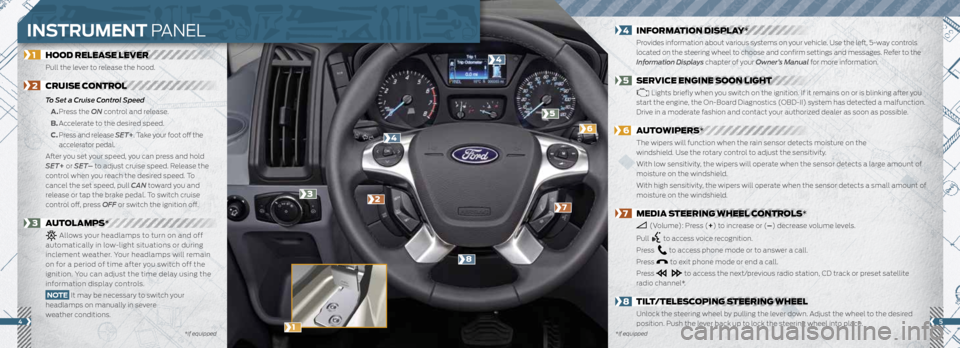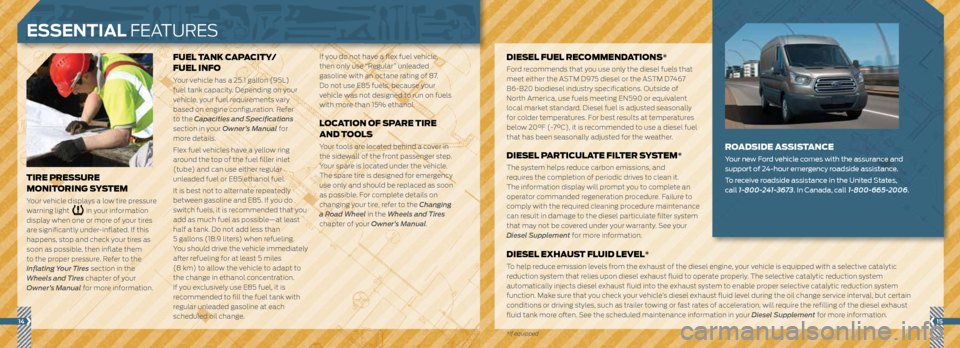tow FORD TRANSIT CONNECT 2015 2.G Quick Reference Guide
[x] Cancel search | Manufacturer: FORD, Model Year: 2015, Model line: TRANSIT CONNECT, Model: FORD TRANSIT CONNECT 2015 2.GPages: 8, PDF Size: 8.97 MB
Page 3 of 8

54
1 HOOD RELEASE LEVER
Pull the lever to release the hood.
2 CRUISE CONTROL
To Set a Cruise Control Speed
A. Press the ON control and release.
B. Accelerate to the desired speed.
C. Press and release SET+ . Take your foot off the
accelerator pedal.
After you set your speed, you can press and hold
SET+ or SET– to adjust cruise speed. Release the
control when you reach the desired speed. To
cancel the set speed, pull CAN toward you and
release or tap the brake pedal. To switch cruise
control off, press OFF or switch the ignition off.
3 AUTOLAMPS*
Allows your headlamps to turn on and off
automatically in low-light situations or during
inclement weather. Your headlamps will remain
on for a period of time after you switch off the
ignition. You can adjust the time delay using the
information display controls.
NOTE It may be necessary to switch your
headlamps on manually in severe
weather conditions.
4 INFORMATION DISPLAY*
Provides information about various systems on your vehicle. Use the left, 5-way controls
located on the steering wheel to choose and confirm settings and messages. Refer to the
Information Displays chapter of your Owner’s Manual for more information.
5 SERVICE ENGINE SOON LIGHT
Lights briefly when you switch on the ignition. If it remains on or is blinking after you
start the engine, the On-Board Diagnostics (OBD-II) system has detected a malfunction.
Drive in a moderate fashion and contact your authorized dealer as soon as possible.
6 AUTOWIPERS*
The wipers will function when the rain sensor detects moisture on the
windshield. Use the rotary control to adjust the sensitivity.
With low sensitivity, the wipers will operate when the sensor detects a large amount of
moisture on the windshield.
With high sensitivity, the wipers will operate when the sensor detects a small amount of
moisture on the windshield.
7 MEDIA STEERING WHEEL CONTROLS*
(Volume): Press (+ ) to increase or (–) decrease volume levels.
Pull
to access voice recognition.
Press
to access phone mode or to answer a call.
Press
to exit phone mode or end a call.
Press
to access the next/previous radio station, CD track or preset satellite
radio channel*.
8 TILT/TELESCOPING STEERING WHEEL
Unlock the steering wheel by pulling the lever down. Adjust the wheel to the desired
position. Push the lever back up to lock the steering wheel into place.
*if equipped
*if equipped
27
5
6
4
4
8
3
INSTRUMENT PANEL
1
Page 8 of 8

1415
FUEL TANK CAPACITY/
FUEL INFO
Your vehicle has a 25.1 gallon (95L)
fuel tank capacity. Depending on your
vehicle, your fuel requirements vary
based on engine configuration. Refer
to the Capacities and Specifications
section in your Owner’s Manual for
more details.
Flex fuel vehicles have a yellow ring
around the top of the fuel filler inlet
(tube) and can use either regular
unleaded fuel or E85 ethanol fuel.
It is best not to alternate repeatedly
between gasoline and E85. If you do
switch fuels, it is recommended that you
add as much fuel as possible—at least
half a tank. Do not add less than
5 gallons (18.9 liters) when refueling.
You should drive the vehicle immediately
after refueling for at least 5 miles
(8 km) to allow the vehicle to adapt to
the change in ethanol concentration.
If you exclusively use E85 fuel, it is
recommended to fill the fuel tank with
regular unleaded gasoline at each
scheduled oil change. If you do not have a flex fuel vehicle,
then only use “Regular” unleaded
gasoline with an octane rating of 87.
Do not use E85 fuels, because your
vehicle was not designed to run on fuels
with more than 15% ethanol.
LOCATION OF SPARE TIRE
AND TOOLS
Your tools are located behind a cover in
the sidewall of the front passenger step.
Your spare is located under the vehicle.
The spare tire is designed for emergency
use only and should be replaced as soon
as possible. For complete details on
changing your tire, refer to the Changing
a Road Wheel in the Wheels and Tires
chapter of your Owner’s Manual.
TIRE PRESSURE
MONITORING SYSTEM
Your vehicle displays a low tire pressure
warning light
in your information
display when one or more of your tires
are significantly under-inflated. If this
happens, stop and check your tires as
soon as possible, then inflate them
to the proper pressure. Refer to the
Inflating Your Tires section in the
Wheels and Tires chapter of your
Owner’s Manual for more information.
DIESEL FUEL RECOMMENDATIONS*
Ford recommends that you use only the diesel fuels that
meet either the ASTM D975 diesel or the ASTM D7467
B6-B20 biodiesel industry specifications. Outside of
North America, use fuels meeting EN590 or equivalent
local market standard. Diesel fuel is adjusted seasonally
for colder temperatures. For best results at temperatures
below 20°F (-7°C), it is recommended to use a diesel fuel
that has been seasonally adjusted for the weather.
DIESEL PARTICULATE FILTER SYSTEM*
The system helps reduce carbon emissions, and
requires the completion of periodic drives to clean it.
The information display will prompt you to complete an
operator commanded regeneration procedure. Failure to
comply with the required cleaning procedure maintenance
can result in damage to the diesel particulate filter system
that may not be covered under your warranty. See your
Diesel Supplement for more information.
ROADSIDE ASSISTANCE
Your new Ford vehicle comes with the assurance and
support of 24-hour emergency roadside assistance.
To receive roadside assistance in the United States,
call 1-800-241-3673. In Canada, call 1-800-665-2006.
ESSENTIAL FEATURES
DIESEL EXHAUST FLUID LEVEL*
To help reduce emission levels from the exhaust of the diesel engine, your vehicle is equipped with a selective catalytic
reduction system that relies upon diesel exhaust fluid to operate properly. The selective catalytic reduction system
automatically injects diesel exhaust fluid into the exhaust system to enable proper selective catalytic reduction system
function. Make sure that you check your vehicle’s diesel exhaust fluid level during the oil change service interval, but certain
conditions or driving styles, such as trailer towing or fast rates of acceleration, will require the refilling of the diesel exhaust
fluid tank more often. See the scheduled maintenance information in your Diesel Supplement for more information.
*if equipped